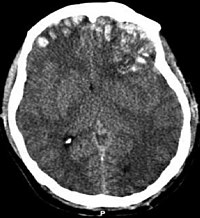
Photo from wikipedia
Traumatic brain injury (TBI) affects 69 million people worldwide each year, and acute traumatic epidural hematoma (atEDH) is a frequent and severe consequence of TBI. The aim of the study… Click to show full abstract
Traumatic brain injury (TBI) affects 69 million people worldwide each year, and acute traumatic epidural hematoma (atEDH) is a frequent and severe consequence of TBI. The aim of the study is to use machine learning (ML) algorithms to predict in-hospital mortality, non-home discharges, prolonged length of stay (LOS), prolonged length of intensive care unit stay (ICU-LOS), and major complications in patients with atEDH and incorporate the resulting ML models into a user-friendly web application for use in the clinical settings. The American College of Surgeons (ACS) Trauma Quality Program (TQP) database was used to identify patients with atEDH. Four ML algorithms (XGBoost, LightGBM, CatBoost, and Random Forest) were utilized and the best performing models were incorporated into an open-access web application to predict the outcomes of interest. The study found that the ML algorithms had high area under the receiver operating characteristic curve (AUROC) values in predicting outcomes for patients with atEDH. In particular, the algorithms had an AUROC value range of between 0.874 to 0.956 for in-hospital mortality, 0.776 to 0.798 for non-home discharges, 0.737 to 0.758 for prolonged LOS, 0.712 to 0.774 for prolonged ICU-LOS, and 0.674 to 0.733 for major complications. The following link will take users to the open-access web application designed to generate predictions for individual patients based on their characteristics: huggingface.co/spaces/MSHS-Neurosurgery-Research/TQP-atEDH. This study aimed to improve the prognostication of patients with atEDH using ML algorithms and developed a web application for easy integration in clinical practice. It found that ML algorithms can aid in risk stratification and have significant potential for predicting in-hospital outcomes. Results demonstrated excellent performance for predicting in-hospital mortality and fair performance for non-home discharges, prolonged LOS and ICU-LOS, and poor performance for major complications.
Journal Title: Journal of neurotrauma
Year Published: 2023
Link to full text (if available)
Share on Social Media: Sign Up to like & get
recommendations!